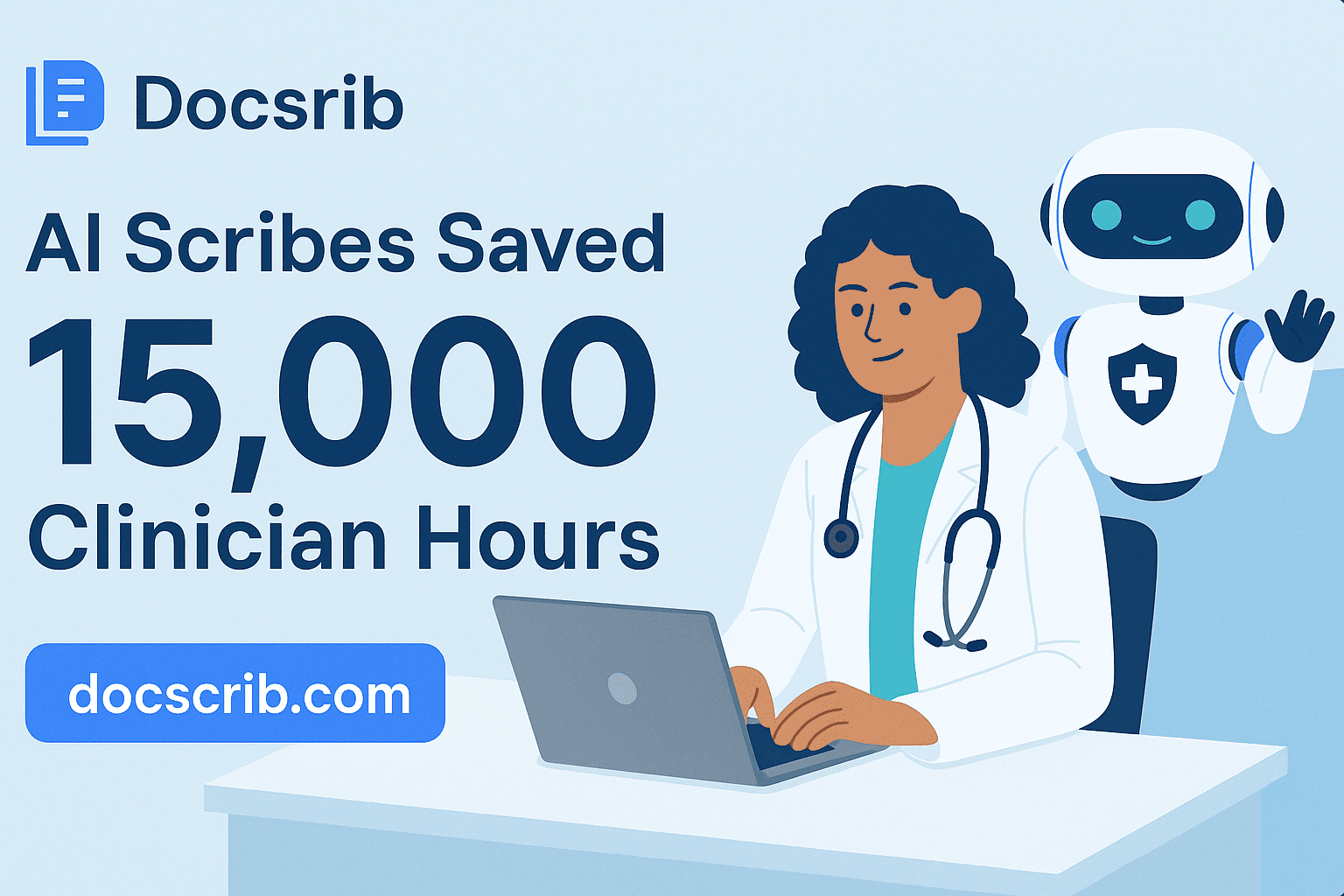Updated on: July 18, 2025
Burnout. After-hours charting. Too much time with a keyboard, not enough with patients. If you’re a clinician today, these are more than buzzwords—they’re part of daily life.
But what if a solution already exists? One that’s not just theoretical, but proven to work?
At DocScrib, we’re proud to report a major milestone:
AI medical scribes have helped save over 15,000 clinician hours across our user base.
And that’s just the beginning.
In this post, we’ll explore:
✅ How AI scribes work
✅ The story behind the 15,000-hour milestone
✅ What this means for your practice
✅ How you can start seeing results today
The Problem: Too Much Time Spent on Documentation
Modern EHRs are powerful—but they weren’t built with clinician time in mind. Studies show that physicians spend:
-
Nearly 16 minutes per patient on documentation
-
Over 50% of their day on EHR-related tasks
-
Multiple hours after clinic catching up on notes
It’s no wonder burnout is on the rise.
That’s why clinicians are turning to a new class of solution: AI Medical Scribes.
What Are AI Medical Scribes?
AI Medical Scribes use artificial intelligence to automatically generate clinical documentation from provider-patient conversations.
Here’s how it works:
-
The AI “listens” during the encounter (live or recorded)
-
It transcribes the dialogue in real-time
-
It structures the note—typically in a SOAP format
-
The provider reviews, edits if necessary, and signs off
With DocScrib, this entire process is seamless, secure, and customizable to your specialty and style.
👉 Experience Docscrib’s AI scribe in action
Breaking It Down: 15,000 Hours Saved and Counting
Let’s put that in perspective:
📊 15,000 hours =
-
625 days
-
78 weeks
-
Or nearly 2 full years of working time reclaimed
Imagine what you could do with that time:
-
See more patients
-
Go home on time
-
Improve work-life balance
-
Focus more on quality care, not clicks
And for hospitals or group practices, multiply that impact across dozens or hundreds of clinicians. The ROI becomes undeniable.
Where Those Hours Went Instead
When we analyzed usage across Docscrib clients, we found those 15,000 saved hours translated to:
-
⏱ Shorter patient throughput times
-
📈 Increased documentation accuracy
-
💬 More time spent with patients
-
😌 Happier, less stressed providers
One clinic even reported a 40% reduction in after-hours charting after implementing DocScrib.
Why Clinicians Love AI Medical Scribes
Here’s what providers say they love most about Docscrib:
Hands-Free Documentation
No more typing during visits. Stay focused on the patient.
SOAP Note Automation
The AI outputs ready-to-review Subjective, Objective, Assessment, and Plan sections.
EHR Integration
Pushes structured notes into systems like Epic, Cerner, and others.
Customizable for Your Style
DocScrib adapts to your tone, specialty, and clinical preferences.
A Look at the Numbers
| Metric | Before AI Scribes | After Using DocScrib |
|---|---|---|
| Average Charting Time per Day | 2+ hours | Under 30 minutes |
| After-Hours Documentation | 4–5 times/week | <1 time/week |
| Clinician Satisfaction (1–10) | 5.6 | 9.1 |
| Patient Face-Time | 60% of visit | 85%+ of visit |
The Secret Behind DocScrib’s Impact
The difference isn’t just AI. It’s how we designed DocScrib to collaborate with humans, not replace them.
With Human-AI Collaboration:
-
The AI handles the repetitive parts
-
You stay in control of the clinical narrative
-
It adapts over time to your feedback and voice
This blend of intelligence + intuition is why we’re seeing such rapid adoption.
👉 Want to see if it fits your workflow? Schedule a Free Demo
Who’s Using AI Medical Scribes?
Clinicians across specialties are adopting AI scribes, including:
-
🧠 Psychiatrists
-
🩺 Internists
-
👩⚕️ Family Physicians
-
🦴 Orthopedists
-
💬 Speech and Occupational Therapists
And institutions ranging from solo practices to multi-site hospital systems are integrating DocScrib to:
-
Improve efficiency
-
Reduce staffing costs
-
Streamline EHR workflows
Overcoming Common Concerns
| Concern | DocScrib’s Solution |
|---|---|
| Data security | HIPAA-compliant, encrypted cloud infrastructure |
| Accuracy | Trained on vast clinical datasets; specialty tuning available |
| Integration pain | Fast onboarding; works with major EHR platforms |
| Loss of control | Final review and approval always stays with the provider |
The Road Ahead: Beyond 15,000 Hours
We’re just getting started.
With more clinics joining each month and AI models continuously improving, we expect to surpass 50,000 hours saved in the near future. And that’s time we’re giving back to:
-
Patients
-
Providers
-
Practices
Final Thoughts: Let’s Put Time Back Where It Belongs
AI Scribes Saved 15,000 Clinician Hours—but that number is more than a metric. It’s a movement.
A shift toward:
✅ Human-first healthcare
✅ Technology that supports, not overwhelms
✅ Smarter documentation powered by AI
👉 📅 Book a Free Demo of DocScrib
👉 Or visit DocScrib.com to learn how we’re redefining documentation in 2025.
Frequently Asked Questions (FAQ)
1. How did DocScrib save 15,000 clinician hours?
By automating documentation through AI-powered scribing, reducing manual charting time significantly across hundreds of providers.
2. Is Docscrib secure and HIPAA-compliant?
Absolutely. We use enterprise-grade encryption and meet all HIPAA security requirements.
3. What types of clinicians benefit most?
All specialties benefit, but especially those with high documentation loads like internal medicine, psychiatry, and primary care.
4. How do I get started?
Click here to book a free personalized demo and see how Docscrib fits into your current workflow.
